Key takeaways:
- A positive learning environment fosters emotional safety, encouraging student expression and collaboration while viewing mistakes as growth opportunities.
- Music education develops essential life skills, boosts self-esteem, fosters emotional intelligence, and promotes cultural awareness among students.
- Diverse teaching methods, such as integrating technology and exploring global music genres, enhance student engagement and broaden their perspectives.
- Building strong relationships through trust, personal connections, and acknowledging student achievements creates a supportive classroom atmosphere.
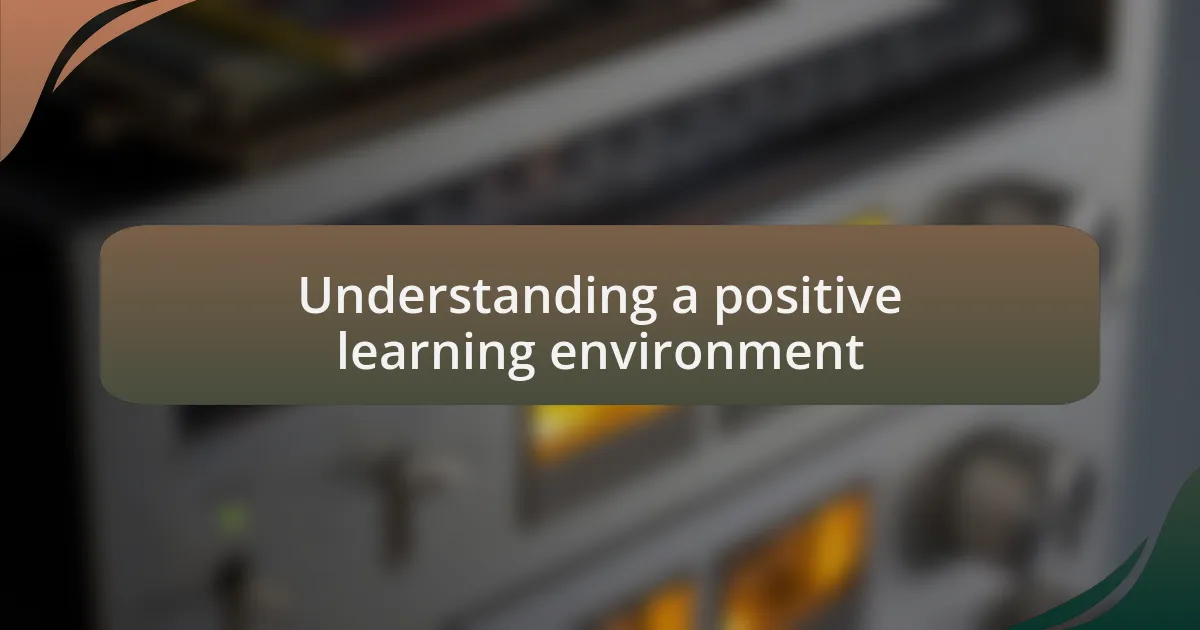
Understanding a positive learning environment
A positive learning environment is about more than just physical space; it encompasses the emotional and social atmosphere that permeates the classroom. I remember a time when I observed a classroom where laughter and enthusiasm were as prevalent as the music itself. It made me realize how vital it is to cultivate an atmosphere where students feel safe and motivated to express themselves.
Think about it: how can one truly engage with music if they are worried about judgment or failure? In my experience, creating a space where mistakes are viewed as opportunities for growth is essential. I often share my own learning struggles with students, which helps break down barriers and fosters a sense of community. This connection not only enhances the learning process but also builds trust among students.
Furthermore, a supportive environment encourages collaboration. When students collaborate, they share their unique perspectives and learn from each other. I’ve noticed that group projects in music education frequently lead to spontaneous creativity and innovative outcomes. This dynamic not only enriches their learning experience but reinforces the idea that everyone has something valuable to contribute.
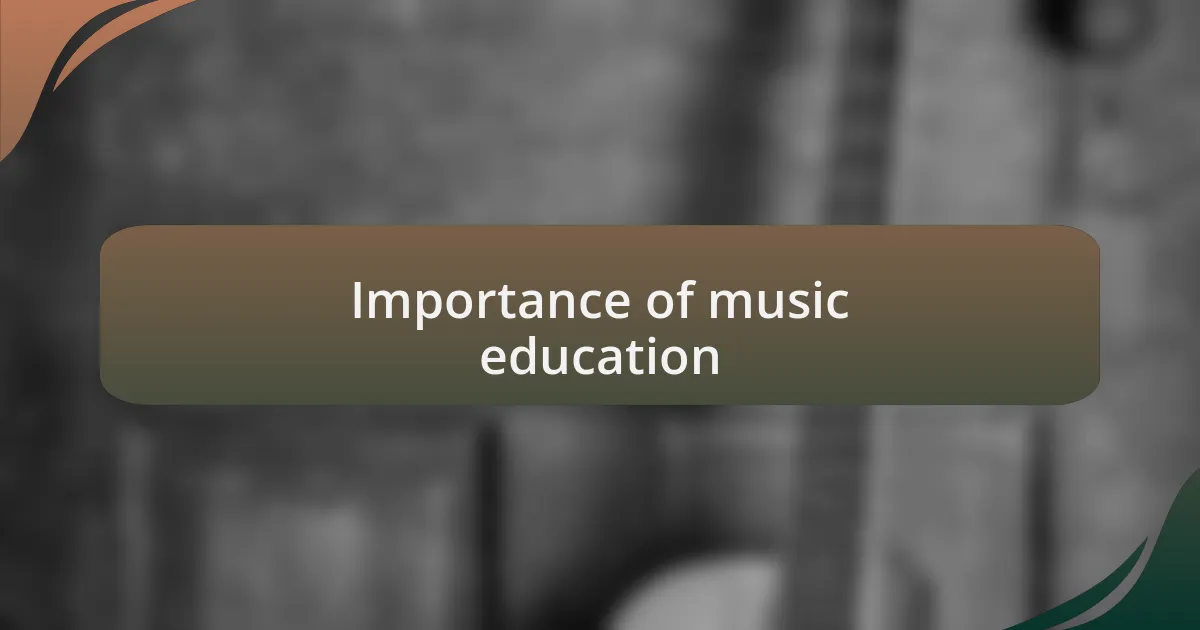
Importance of music education
Music education holds immense value in developing not just musical skills, but also critical life skills. I remember a student who initially struggled with self-doubt, believing they could never grasp musical concepts. Through music, that same student blossomed, gaining confidence that rippled into other areas of their life. Isn’t it powerful how the act of playing an instrument or singing in a choir can bolster a young person’s self-esteem?
Moreover, engaging with music fosters emotional intelligence. I’ve seen firsthand how my students learn to express their feelings through melodies and rhythms, creating a deeper understanding of their emotions and those of others. This ability to connect to one’s own feelings is essential for personal growth. Can you think of a time when music helped you process your emotions? I often reminisce about how a song’s lyrics have comforted me during tough times.
Finally, music education promotes cultural awareness and appreciation. Each time I introduce a lesson on a different genre or artist, I can see students’ eyes widen with curiosity. They come to realize that music transcends boundaries, telling stories of diverse experiences and histories. Isn’t it incredible how a simple piece of music can bridge gaps between different cultures, fostering unity and respect among students? This realization leads to rich discussions and an enriched learning atmosphere.
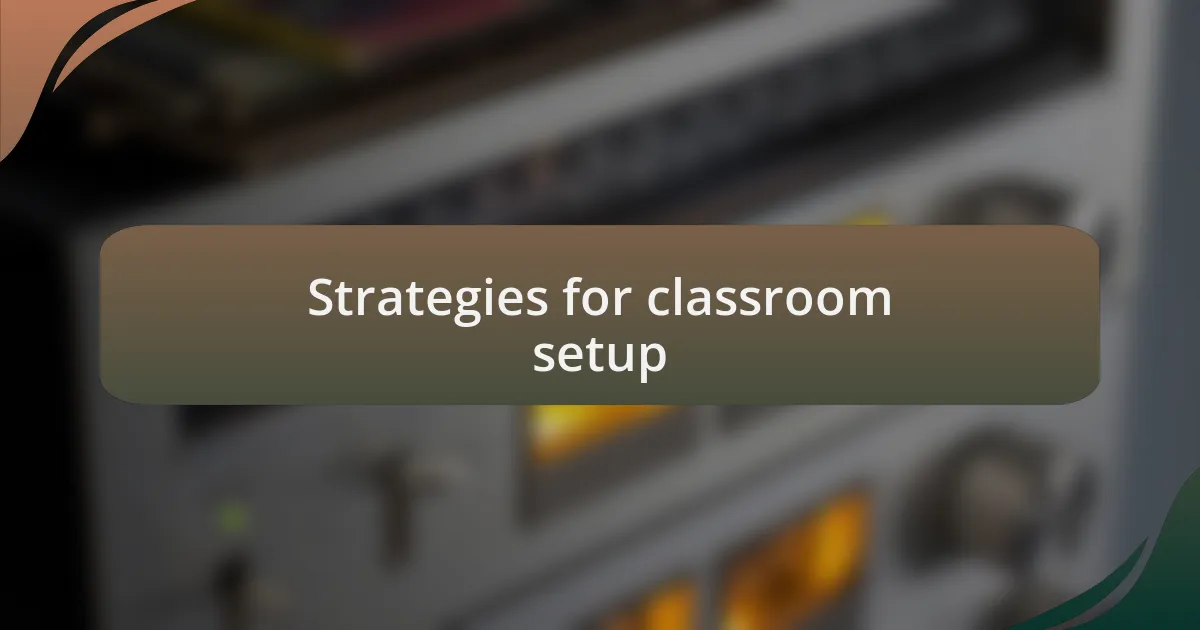
Strategies for classroom setup
Creating a positive learning environment starts with thoughtful classroom setup. I’ve learned that arranging seating to encourage collaboration can dramatically shift the energy in the room. For instance, I often opt for circular seating arrangements, which not only invite discussion but also make every student feel included. Have you ever noticed how a simple change in layout can transform student dynamics?
Lighting is another critical factor that often gets overlooked in the setup. During one of my classes, I dimmed the lights while we explored the emotional depth of a piece, and it changed the atmosphere entirely. The students became more introspective, connecting with the music on a deeper level. Isn’t it fascinating how the right ambiance can enhance concentration and creativity?
Lastly, incorporating musical instruments and resources within easy reach can foster a sense of ownership among students. I remember a time when I let my students organize their own space, choosing where to place instruments and sheet music. Their excitement was palpable! When students feel like they have a stake in their environment, their motivation to learn skyrockets. What strategies do you think could engage your students even more?
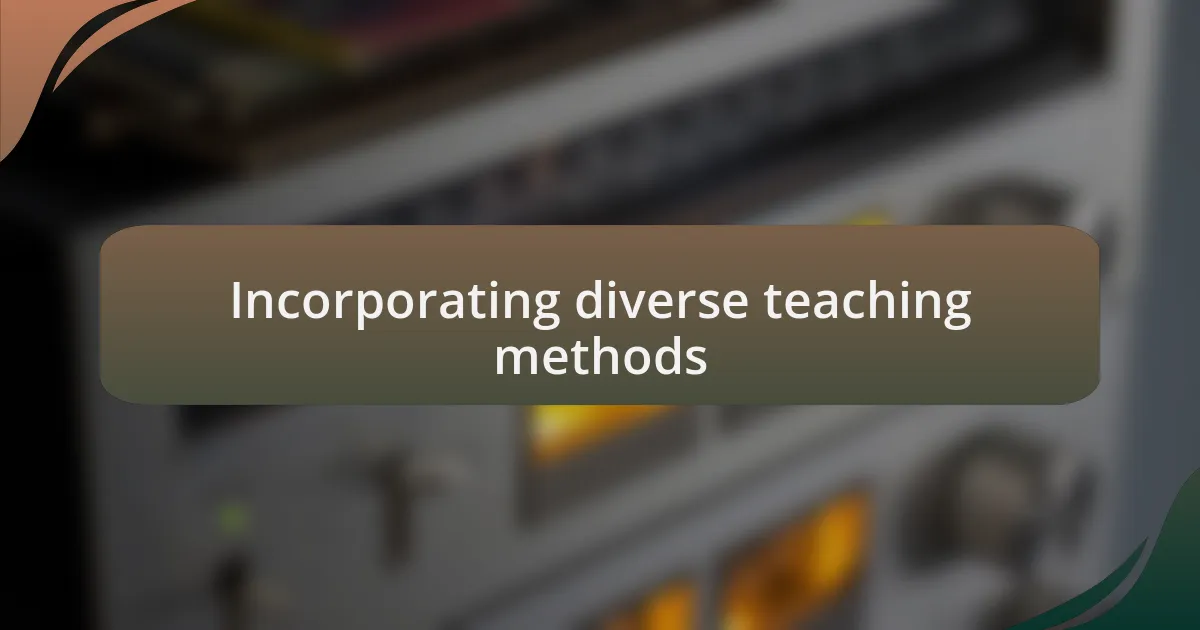
Incorporating diverse teaching methods
Incorporating diverse teaching methods is essential for reaching every learner in a music education setting. I’ve found that blending traditional instruction with experiential activities keeps students engaged. For instance, while teaching rhythmic patterns, I often include body percussion, allowing students to explore beats physically. It’s incredible how quickly their enthusiasm grows when they can feel the music in their bones. Have you tried mixing different styles in your lessons?
One approach I particularly enjoy is integrating technology into my teaching. During a unit on music composition, I introduced software that let students experiment with digital music creation. Watching their faces light up as they brought their ideas to life was rewarding. They were highly motivated to share their unique soundscapes, which ignited a collaborative spirit among the class. How does technology play a role in your teaching?
I also embrace cultural diversity in music by exploring genres from around the world. I recall a time when I introduced students to traditional African drumming. The energy in the room was electric, as students learned not just about the rhythms but also the stories behind them. This connection to different cultures broadens their perspectives and appreciation for music. How can you incorporate global influences into your lessons to enrich your students’ experience?
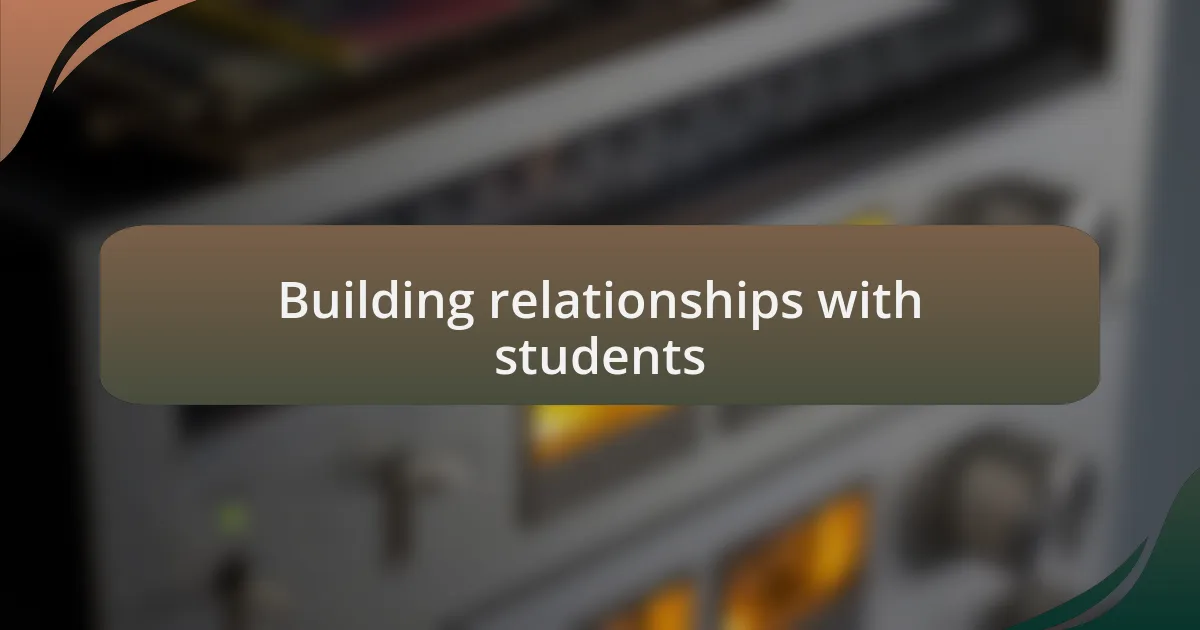
Building relationships with students
Building strong relationships with students is at the heart of a positive learning environment. I remember a particularly shy student who struggled to participate in class discussions. By taking the time to chat before and after lessons, I discovered her love for musical theater. That simple connection transformed her from a reserved observer into an enthusiastic contributor, willing to share her insights with the class. Have you found ways to connect with your quieter students?
Trust is another crucial element in building relationships. I often create opportunities for students to share their thoughts and ideas during lessons, which fosters a sense of belonging. For example, during a group project, I encouraged students to voice their preferences on song choices. This not only empowered them but also led to deeper discussions about their musical tastes. How do you encourage your students to share openly?
At times, a personal touch makes all the difference. I like to celebrate individual achievements, no matter how small, by recognizing a student’s progress during class. One day, a student who had been struggling to keep up played a piece beautifully for the class. The pride on her face was unforgettable. Moments like this reinforce our bond and motivate others to strive for their best. What strategies do you implement to acknowledge student successes?
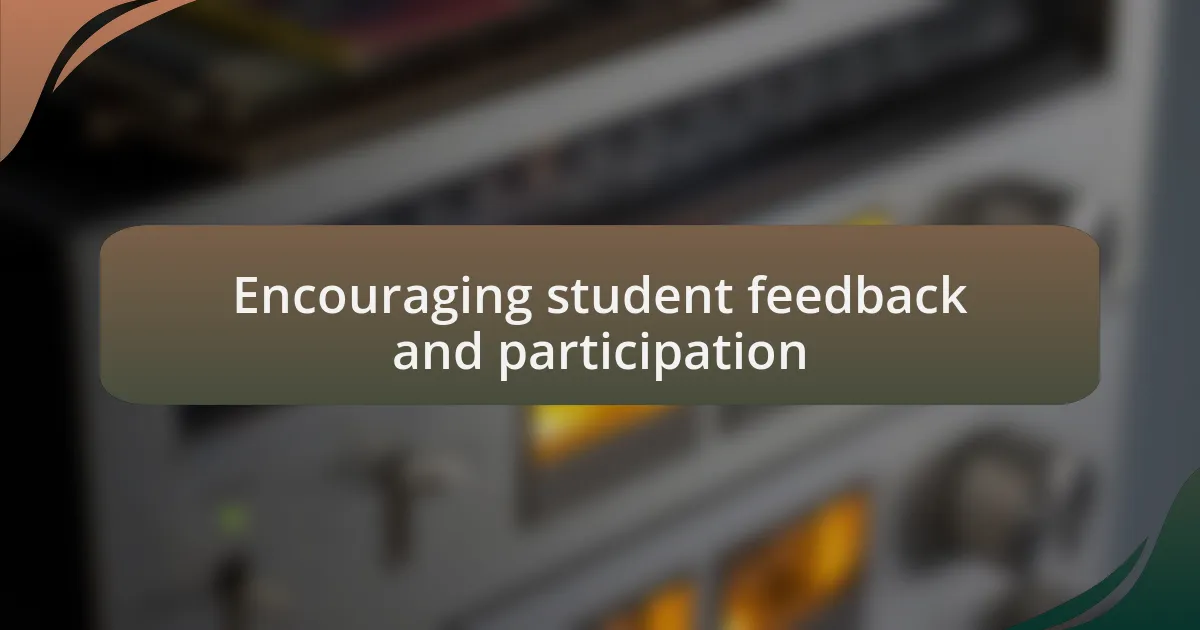
Encouraging student feedback and participation
Encouraging students to provide feedback not only validates their voices but also enhances their engagement in the learning process. I remember one particular class where I introduced a simple feedback box for students to share their thoughts anonymously. The insights we gained were transformative; students expressed preferences on song selections and even suggested new teaching methods. Have you ever noticed how much more invested students become when they feel their input matters?
Participation thrives when students feel comfortable and safe to express themselves. I often use circle time for group discussions, allowing each student a chance to share their ideas without fear of judgment. I vividly recall a student who was hesitant at first but gradually began to open up, sharing his perspective on a piece we were studying. It was incredible to witness how his confidence flourished as he realized his opinions were valued. How do you create a space where every student feels they can contribute?
I also find that incorporating interactive activities can drive participation. For instance, during a recent lesson, I split the class into small groups to brainstorm lyrics for an original song. The energy in the room was electric, and I could see students who typically shied away from participating come alive with creativity. When students see their contributions taking shape, it fosters a collaborative spirit and deepens their connection to the music we’re exploring. What collaborative projects have you found effective in sparking student involvement?